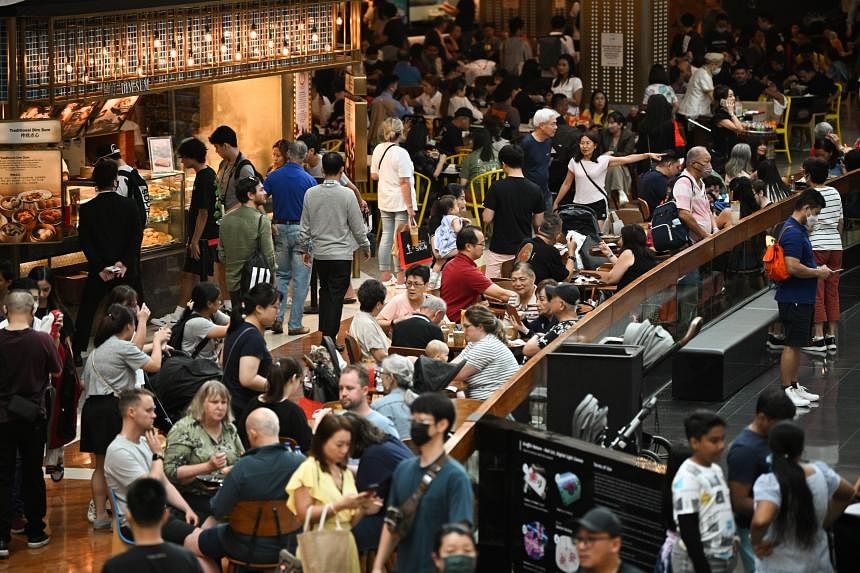In praise of the sound of silence
Amid the din of a bustling city at this time of the year, let us also appreciate the joy of stillness and quiet

Singapore becomes a different country towards the end of the year as the sounds of the festive season envelope you in malls. Different renditions of Christmas carols – Silent Night included – greet you as you move from shop to shop. Then past Dec 25, the thumpety thump thump of Frosty the Snowman gives way to the clash of cymbals and bursts of firecrackers heralding the arrival of the God of Fortune and Chinese New Year.
I suspect I am not alone in hankering after the tranquillity of the days during the Covid-19 circuit breaker in April and May 2020.
As traffic volume dropped and people stayed home for long stretches, there was a certain stillness all around. Bird song could be heard more clearly. The mind could be still and pick up subtle details in the middle of the day, whether it was the rustling of the leaves outside or the low whirr of the standing fan as you worked from home.
Today, of course it’s back to the unrelenting bustle of the city. It’s the same familiar urban energy in major metropolises, to be fair, with all kinds of acoustic and visual stimuli beckoning you. You put on the earphones but short of damaging your own eardrums by maxing the volume on your playlist, ambient sound is near impossible to shut out.
Even along the park connectors, delivery food riders and leisure cyclists whizz by with their music amped up, determined to share their music tastes with everyone. The aunties who meet to do their daily exercises seem to compete with their own sound system which calls out Chinese instructions amid the strains of tinkling guzheng music. Worse, on occasion, you encounter park maintenance workers on their rounds, the menacing buzz of their grass cutters and the roar of their leaf blowers filling the air with noise along with the whirling confetti of shredded grass and fallen leaves.
Of course, there is the necessity of maintaining our well-cherished parks, but sometimes it seems there is no respite. One imagines: where and when does one find quiet?
The sound of prosperity
It doesn’t help that noise seems to be a marker of a vibrant economy: the piling works for new apartments and the ear-grinding home renovations reflect a buoyant property market. Whether it’s a neighbouring unit in your apartment block or the construction works in your precinct, noise sometimes feels like it’s inescapable.
You take some comfort that Singapore is relatively quiet compared to Dhaka and Ho Chi Minh City, ranked in the UN Environment Programme 2022 report as the noisiest Asian and South-east Asian cities respectively. The report also points out the consequences of prolonged and high-level sounds from road traffic, railways, or leisure activities. Hearing impairment aside, sleep disturbance and chronic annoyance could lead to poorer mental health and heart diseases as well.
Notwithstanding my own preferences, one wonders if many Singaporeans have a higher threshold for noise, sleeping through the early morning traffic sounds or pumping up the music on their devices during their daily commute.
Perhaps silence is to be avoided, given its associations with absence and sadness. Is that why our festivals and joyous occasions are celebrated with high-volume sounds – processions of percussion instruments, the striking of cymbals, the letting off of firecrackers? Perhaps some of us are wary of silence, being alone with our own thoughts.
The lack of appreciation of silence, one could argue, is a corollary for our discomfort with emptiness. Over the years, we have grown used to a densely packed metropolis, an urban routine of encountering hundreds of strangers every day on public transport. Even our surrounding sea is populated with container ships and oil tankers, a constant reminder that Singapore is one of the busiest ports in the world. An empty metropolis or seascape feels odd, desolate, even lifeless.
A look at our material culture seems to confirm this: Peranakan porcelain and batik prints are crammed with motifs and bright colours, dishes from nasi ambeng to steamboat and pengcai, popular during the Chinese New Year, celebrate abundance and an overflowing assembly of rich components. But surely there is a point where all this becomes excess, and we run the risk of surfeit?
It may do us good to make more space for the simpler things, drawing inspiration from the monochrome beauty of green celadon or Dehua white pottery, for instance. There is beauty in minimalism. In the same vein, could we elevate simple rice porridge and oatmeal in our mental hierarchy of foods? It’s probably better for our health too.
Positive negative space
The idea of negative space in art and architecture reminds us of the importance of emptiness. Negative space is a necessary aspect in the composition and presentation of most visual art works. It gives depth and perspective, allowing the viewer’s eye and mind to focus.
In urban design, negative space mitigates against a sense of claustrophobia, helps us experience the human scale of streetscapes as well as appreciate public art and thoughtful architecture.
Contemporary music lovers would know John Cage’s infamous 4’33” work – essentially a conceptual performance where a pianist sits at the piano, occasionally turning the score sheet but not playing a single note. Yes, it is probably too extreme but the point is well-registered: We need to better appreciate our auditory environment and of course, silence is needed in music: it’s part of the natural complementarity between the two.
At home, one artwork that seemingly is about nothing is Cheo Chai Hiang’s 5’ x 5’ (Singapore River), a square of five feet by five feet straddling the floor and wall. Sometimes re-presented as a square of projected light or an empty space marked by tape, 5’ x 5’ is regarded as an important work in Singapore’s art history in its resistance of visual art as representational and realistic, its commentary on the overuse of the Singapore River as a subject, and its forcing the viewer to consider what we value as aesthetic and how we see art.
In a hyper-stimulated, constantly energised city, high-minded art may not be the best fix for those searching for seemingly elusive quiet or emptier vistas though.
Perhaps some time abroad in one of the less touristy nearby destinations known for their natural beauty? New panoramas, devoid of urban built-up, may be a balm for the sensory fatigue.
Or stay home but invest in double-glazed windows and noise-cancelling earphones? And do give feedback to the Municipal Services Office if the external noise in your living environment seems excessive or protracted. It’s better than waxing nostalgic about the quiet time afforded by Covid-19 health protocols which grounded entire cities around the world to a near halt.
Here’s wishing all readers a peaceful new year, filled only with good sounds at a friendly decibel level.
- Paul Tan is a PhD candidate in creative writing at Nanyang Technological University.
Join ST's Telegram channel and get the latest breaking news delivered to you.








No comments:
Post a Comment